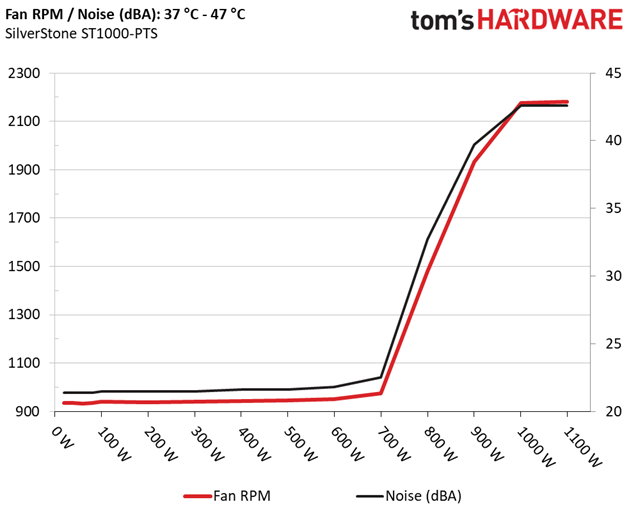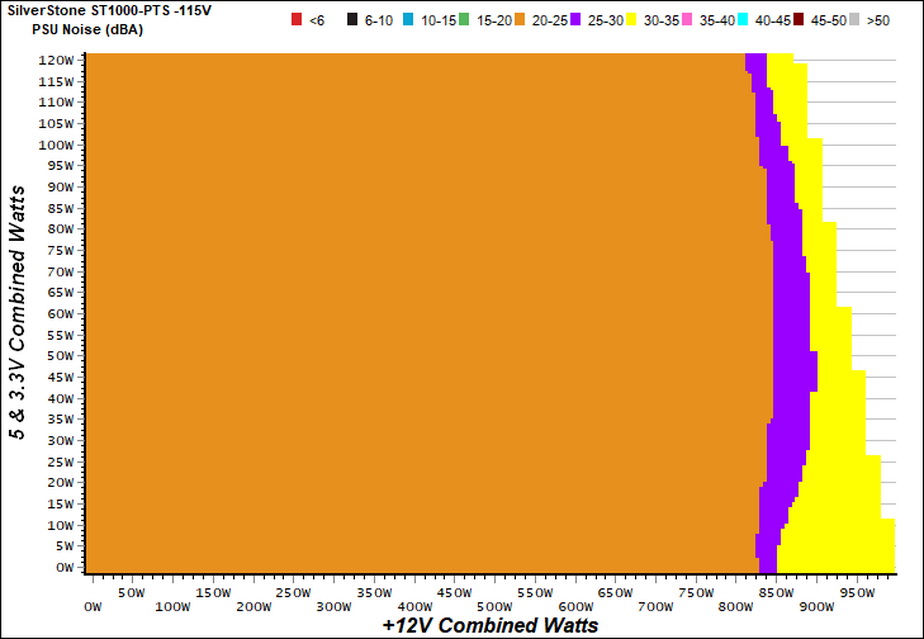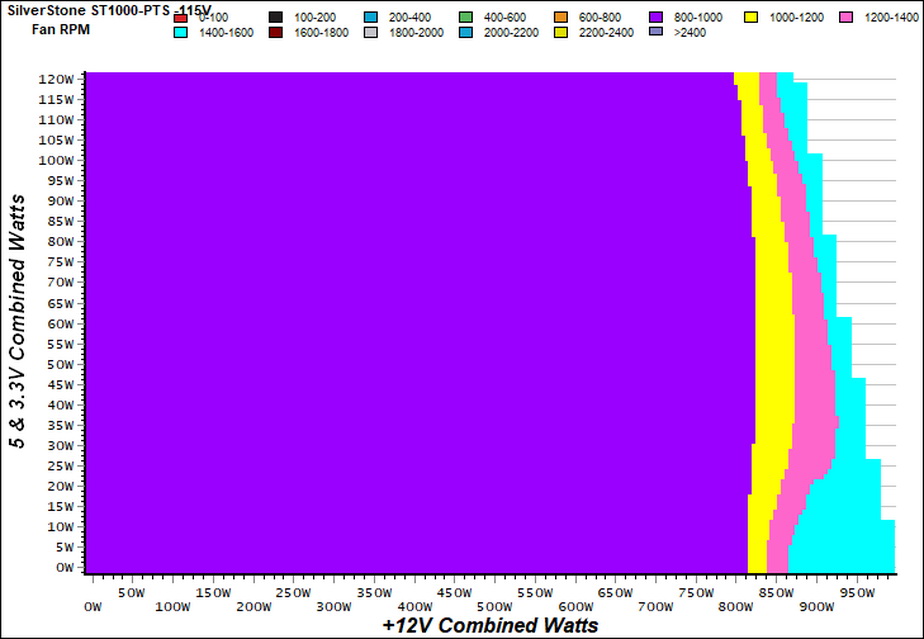SilverStone ST1000-PTS Power Supply Review: Downsizing To The Extreme
Why you can trust Tom's Hardware
Load Regulation, Hold-Up Time, Inrush Current, Efficiency and Noise
To learn more about our PSU tests and methodology, please check out How We Test Power Supply Units.
Primary Rails and 5VSB Load Regulation
The following charts show the main rails' voltage values recorded between a range of 40W up to the PSU's maximum specified load, along with the deviation (in percent). Tight regulation is an important consideration every time we review a power supply, because it facilitates constant voltage levels despite varying loads. Tight load regulation also, among other factors, improves the system’s stability, especially under overclocked conditions and, at the same time, it applies less stress to the DC-DC converters that many system components utilize.
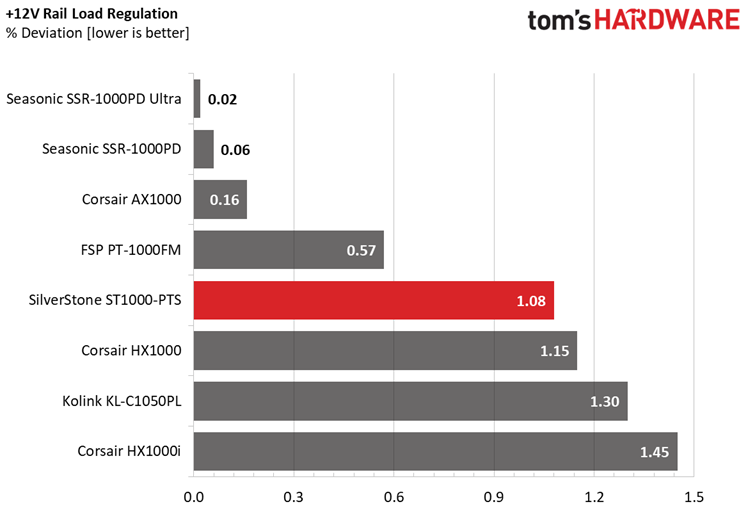
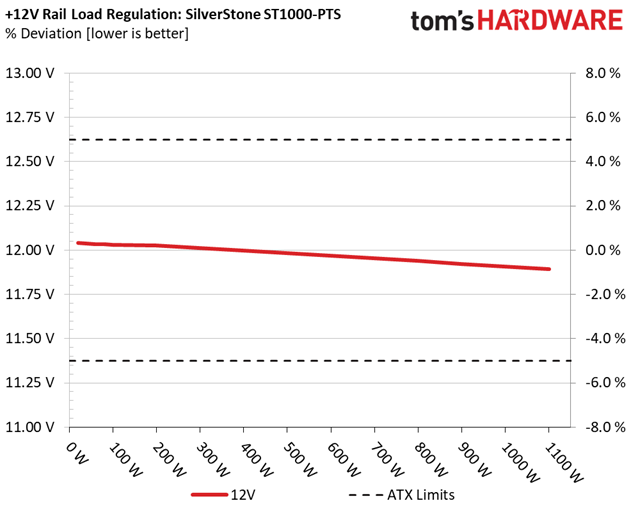

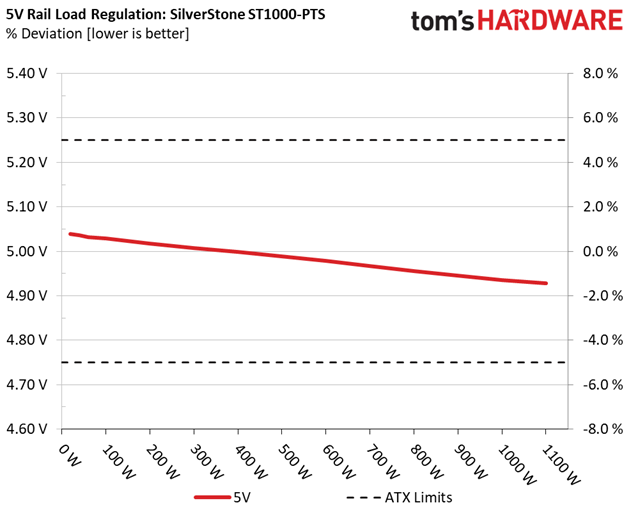



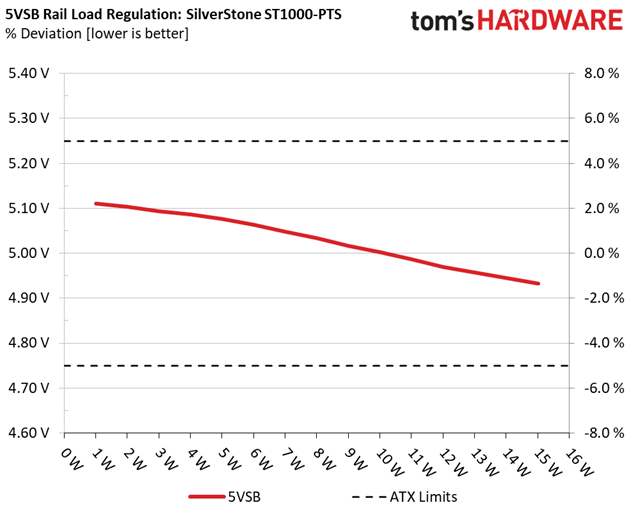
The load regulation at +12V might not be super tight, but it is decent. On the minor rails, there is (lots of) room for improvement though.
Hold-Up Time
Put simply, hold-up time is the amount of time that the system can continue to run without shutting down or rebooting during a power interruption.
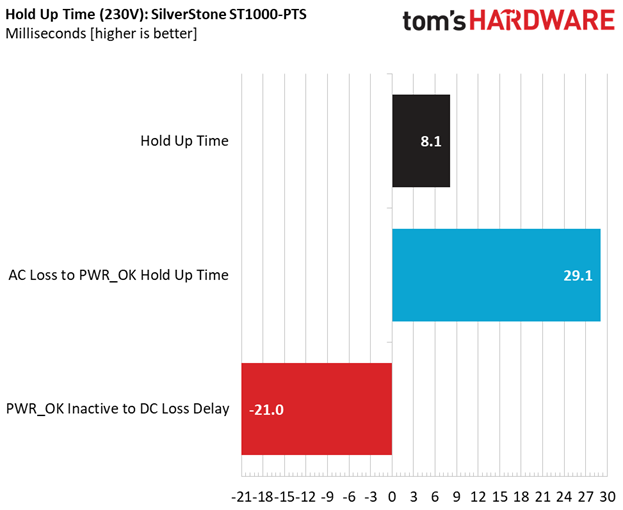

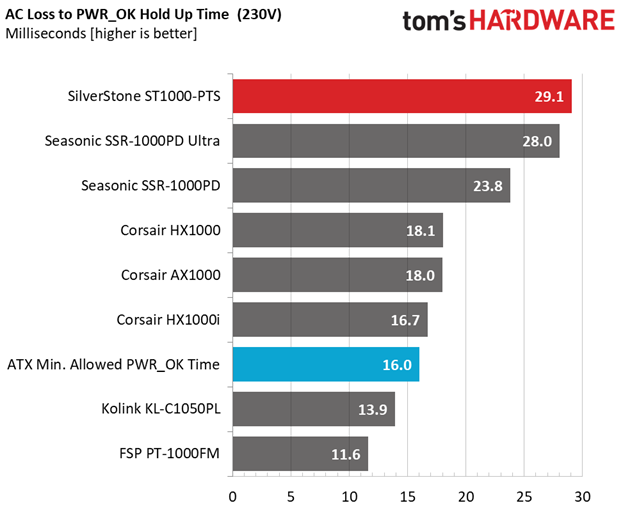
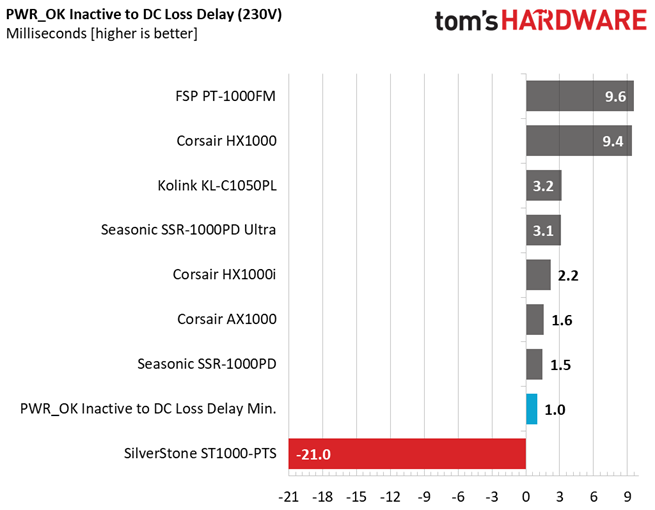
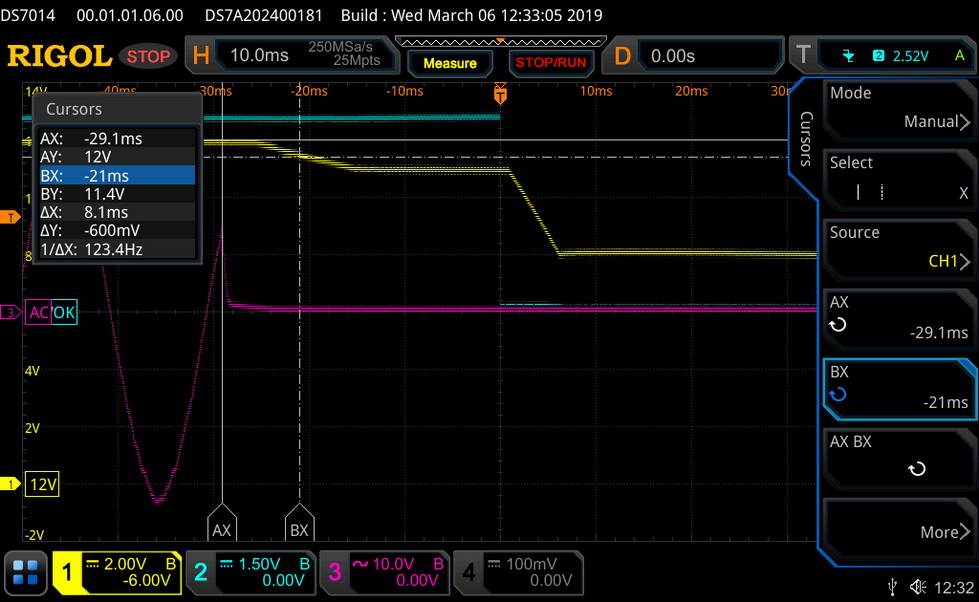
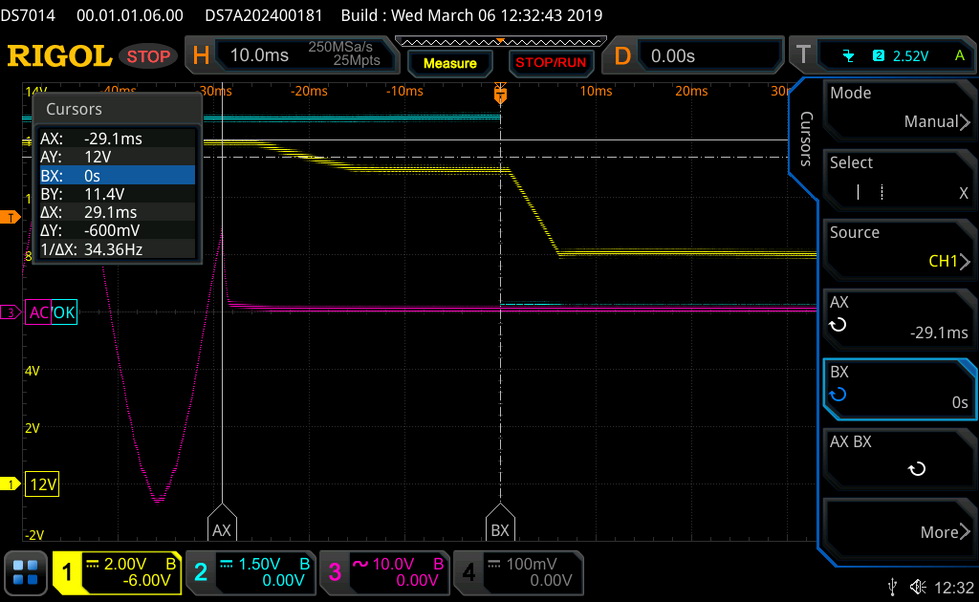
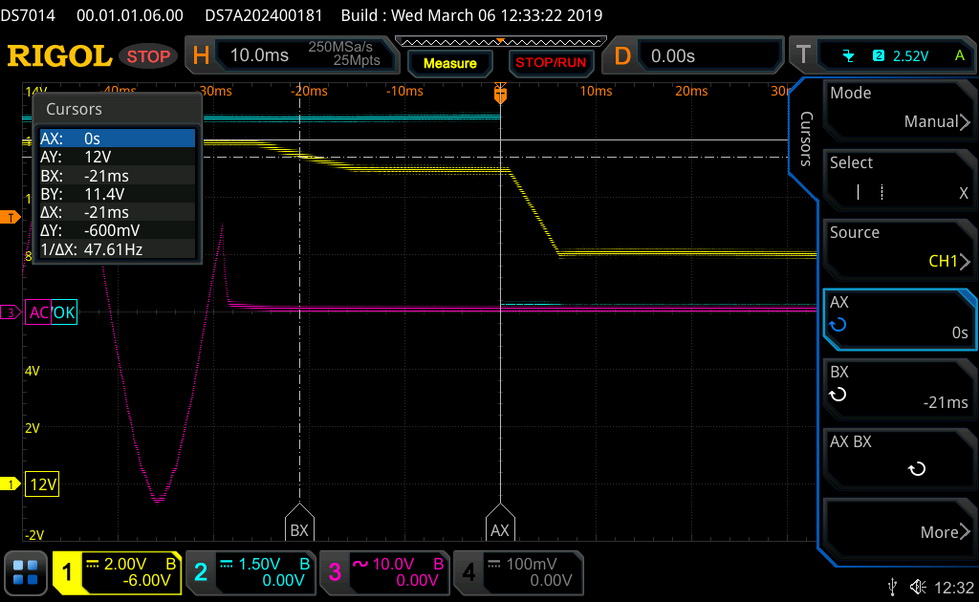
Something is wrong here. Once the power is cut, the +12V rail's voltage drops almost immediately to a lower level, below 11.4V, and the power ok signal drops too late, so we measure a negative power ok inactive to DC loss delay. SilverStone should fix this the sooner the possible.
Inrush Current
Inrush current, or switch-on surge, refers to the maximum, instantaneous input current drawn by an electrical device when it is first turned on. A large enough inrush current can cause circuit breakers and fuses to trip. It can also damage switches, relays, and bridge rectifiers. As a result, the lower the inrush current of a PSU right as it is turned on, the better.


The registered inrush currents are very low, which is a good thing of course.
Get Tom's Hardware's best news and in-depth reviews, straight to your inbox.
10-110% Load Tests
These tests reveal the ST1000-PTS’s load regulation and efficiency levels under high ambient temperatures. They also show how the fan speed profile behaves under increased operating temperatures.
| Test # | 12V | 5V | 3.3V | 5VSB | DC/AC (Watts) | Efficiency | Fan Speed (RPM) | PSU Noise (dB[A]) | Temps (In/Out) | PF/AC Volts |
|---|---|---|---|---|---|---|---|---|---|---|
| 1 | 6.519A | 1.989A | 1.994A | 0.985A | 100.026 | 87.331% | 940 | 21.5 | 39.55°C | 0.968 |
| 12.031V | 5.029V | 3.306V | 5.077V | 114.537 | 43.04°C | 115.10V | ||||
| 2 | 14.040A | 2.990A | 3.002A | 1.185A | 199.739 | 91.659% | 938 | 21.5 | 40.84°C | 0.990 |
| 12.026V | 5.018V | 3.295V | 5.063V | 217.915 | 44.98°C | 115.10V | ||||
| 3 | 21.915A | 3.494A | 3.499A | 1.387A | 299.240 | 92.839% | 941 | 21.5 | 41.14°C | 0.995 |
| 12.012V | 5.008V | 3.286V | 5.048V | 322.323 | 45.83°C | 115.10V | ||||
| 4 | 29.881A | 4.001A | 4.027A | 1.590A | 399.687 | 92.705% | 944 | 21.6 | 41.56°C | 0.997 |
| 11.997V | 4.999V | 3.278V | 5.033V | 431.140 | 46.85°C | 115.12V | ||||
| 5 | 37.493A | 5.014A | 5.050A | 1.794A | 499.792 | 92.493% | 946 | 21.6 | 42.36°C | 0.998 |
| 11.983V | 4.989V | 3.267V | 5.017V | 540.359 | 48.56°C | 115.12V | ||||
| 6 | 45.130A | 6.028A | 6.080A | 2.000A | 599.923 | 91.997% | 952 | 21.8 | 42.73°C | 0.999 |
| 11.968V | 4.978V | 3.256V | 5.002V | 652.114 | 49.32°C | 115.12V | ||||
| 7 | 52.748A | 7.048A | 7.120A | 2.207A | 699.613 | 91.604% | 976 | 22.5 | 43.47°C | 0.999 |
| 11.953V | 4.967V | 3.245V | 4.986V | 763.733 | 51.11°C | 115.12V | ||||
| 8 | 60.453A | 8.073A | 8.163A | 2.416A | 800.162 | 90.970% | 1480 | 32.7 | 43.74°C | 0.999 |
| 11.939V | 4.956V | 3.234V | 4.969V | 879.592 | 52.36°C | 115.12V | ||||
| 9 | 68.520A | 8.595A | 8.685A | 2.419A | 899.468 | 90.419% | 1933 | 39.7 | 44.26°C | 0.999 |
| 11.923V | 4.945V | 3.224V | 4.961V | 994.782 | 53.91°C | 115.12V | ||||
| 10 | 76.431A | 9.121A | 9.239A | 3.042A | 999.863 | 89.582% | 2175 | 42.6 | 45.26°C | 0.999 |
| 11.908V | 4.935V | 3.215V | 4.933V | 1116.142 | 55.53°C | 115.12V | ||||
| 11 | 84.947A | 9.133A | 9.256A | 3.048A | 1099.895 | 88.919% | 2181 | 42.6 | 46.64°C | 0.999 |
| 11.892V | 4.928V | 3.208V | 4.923V | 1236.960 | 58.04°C | 115.13V | ||||
| CL1 | 0.146A | 13.999A | 13.999A | 0.000A | 117.137 | 84.516% | 987 | 22.6 | 42.52°C | 0.983 |
| 12.035V | 4.991V | 3.251V | 5.089V | 138.597 | 48.63°C | 115.10V | ||||
| CL2 | 83.006A | 1.002A | 1.000A | 1.000A | 1002.007 | 89.943% | 2175 | 42.6 | 45.39°C | 0.999 |
| 11.912V | 4.964V | 3.254V | 5.011V | 1114.042 | 55.85°C | 115.13V |
Top-notch PF readings and the 80 PLUS Platinum requirements with 20%, 50% and 100% of the unit's max-rated-output are easily met.
20-80W Load Tests
In the following tests, we measure the SST-ST1000-PTS's efficiency at loads significantly lower than 10 percent of its maximum capacity (the lowest load the 80 PLUS standard measures). This is important for representing when a PC is idle, with power-saving features turned on.
| Test # | 12V | 5V | 3.3V | 5VSB | DC/AC (Watts) | Efficiency | Fan Speed (RPM) | PSU Noise (dB[A]) | PF/AC Volts |
|---|---|---|---|---|---|---|---|---|---|
| 1 | 1.197A | 0.496A | 0.481A | 0.196A | 19.510 | 67.415% | 934 | 21.4 | 0.779 |
| 12.041V | 5.039V | 3.317V | 5.111V | 28.940 | 115.12V | ||||
| 2 | 2.465A | 0.993A | 0.994A | 0.392A | 39.968 | 78.574% | 934 | 21.4 | 0.897 |
| 12.038V | 5.036V | 3.313V | 5.103V | 50.867 | 115.11V | ||||
| 3 | 3.658A | 1.490A | 1.479A | 0.589A | 59.417 | 83.363% | 933 | 21.4 | 0.935 |
| 12.035V | 5.032V | 3.310V | 5.094V | 71.275 | 115.11V | ||||
| 4 | 4.919A | 1.989A | 1.996A | 0.787A | 79.799 | 85.832% | 936 | 21.4 | 0.962 |
| 12.033V | 5.030V | 3.307V | 5.086V | 92.971 | 115.10V |
In the first two tests, the efficiency levels are not high. We would like to see above 70% in the first test, and more than 80% in the second one.
Efficiency
Next, we plotted a chart showing the SST-ST1000-PTS’s efficiency at low loads, and loads from 10 to 110 percent of its maximum-rated capacity. The higher a PSU’s efficiency the less energy goes wasted leading to a reduced carbon footprint, besides lower electricity bills.
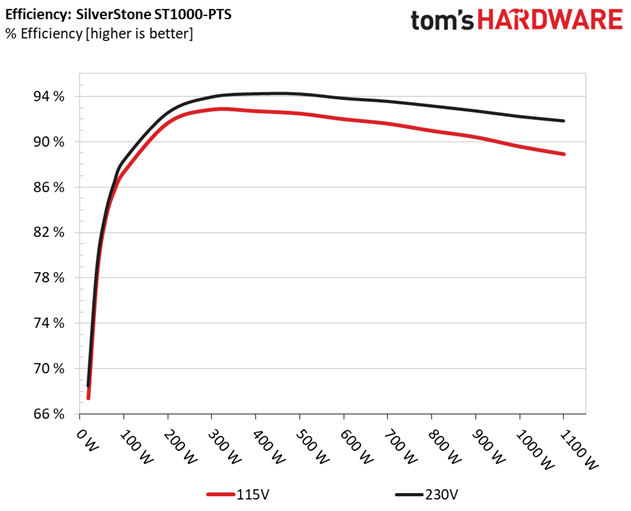
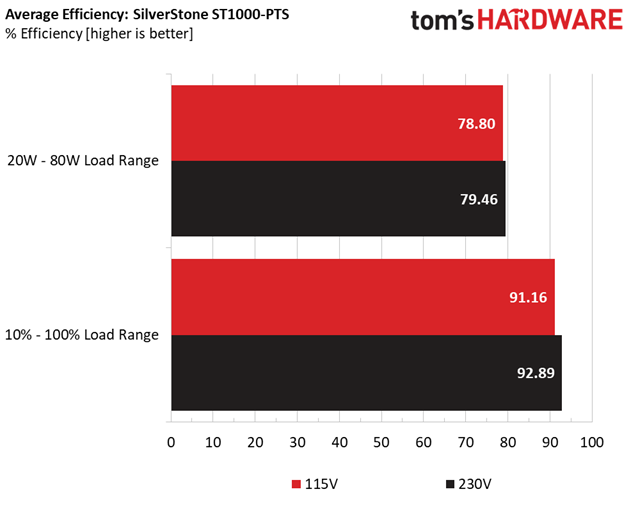
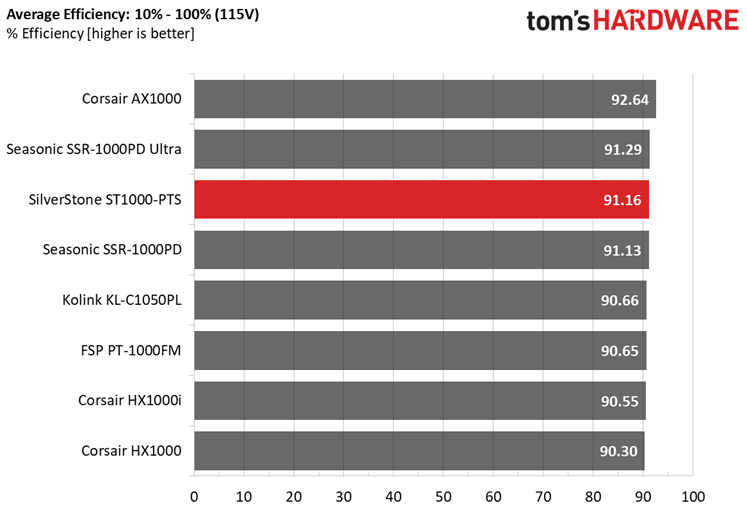
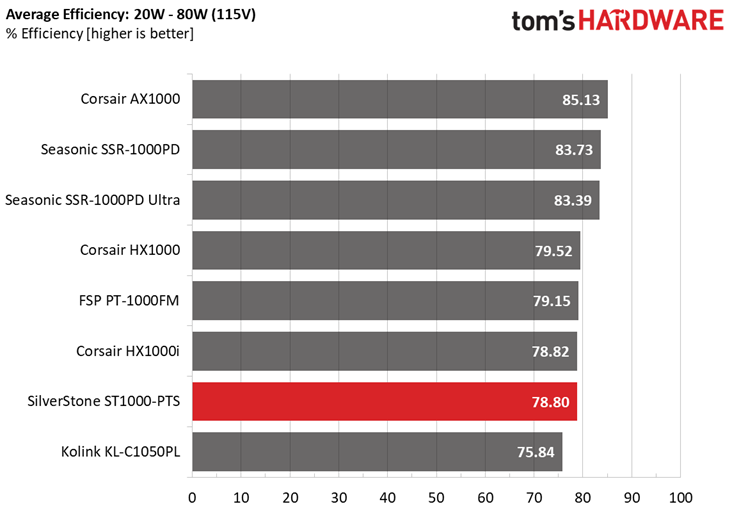
With normal loads the unit's efficiency is high, but under light loads it doesn't perform so well.
5VSB Efficiency
| Test # | 5VSB | DC/AC (Watts) | Efficiency | PF/AC Volts |
|---|---|---|---|---|
| 1 | 0.100A | 0.512 | 72.934% | 0.033 |
| 5.117V | 0.702 | 115.11V | ||
| 2 | 0.250A | 1.278 | 78.117% | 0.077 |
| 5.112V | 1.636 | 115.11V | ||
| 3 | 0.550A | 2.807 | 79.451% | 0.158 |
| 5.103V | 3.533 | 115.11V | ||
| 4 | 1.000A | 5.090 | 80.322% | 0.259 |
| 5.089V | 6.337 | 115.10V | ||
| 5 | 1.500A | 7.611 | 80.523% | 0.342 |
| 5.073V | 9.452 | 115.10V | ||
| 6 | 3.000A | 15.079 | 78.202% | 0.479 |
| 5.027V | 19.282 | 115.10V |
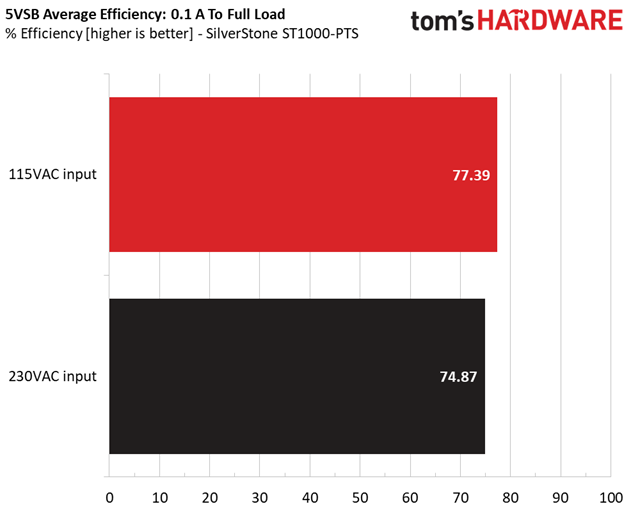
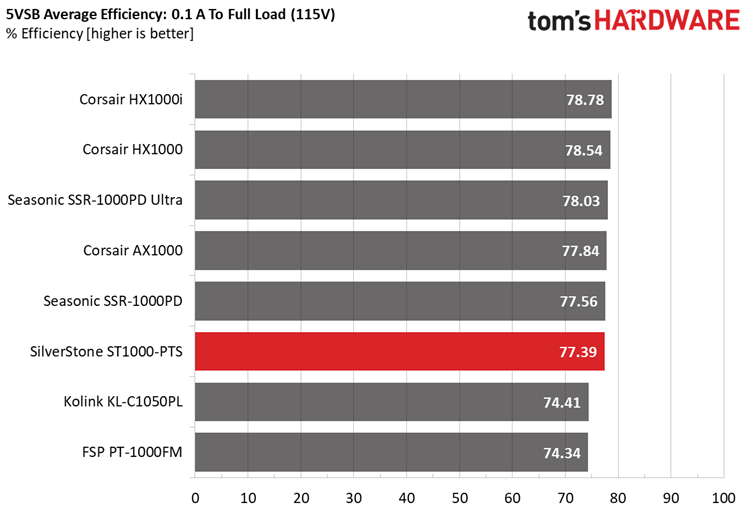
The 5VSB rail's efficiency is close to the competition's levels.
Power Consumption In Idle And Standby
| Mode | 12V | 5V | 3.3V | 5VSB | Watts | PF/AC Volts |
|---|---|---|---|---|---|---|
| Idle | 12.034V | 5.033V | 3.318V | 5.120V | 7.446 | 0.299 |
| 115.1V | ||||||
| Standby | 0.073 | 0.004 | ||||
| 115.1V |
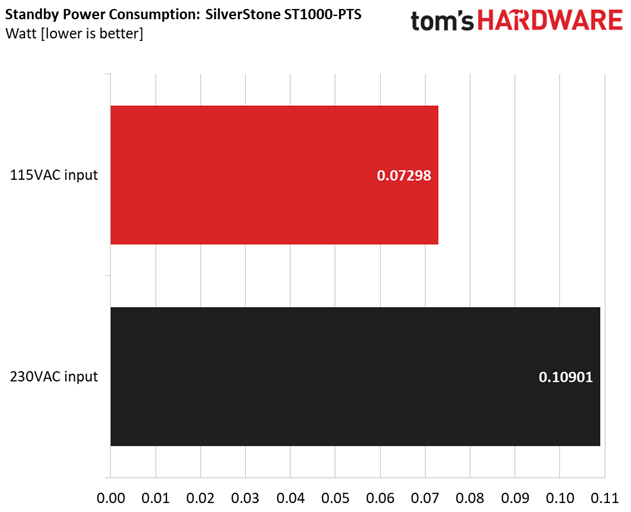
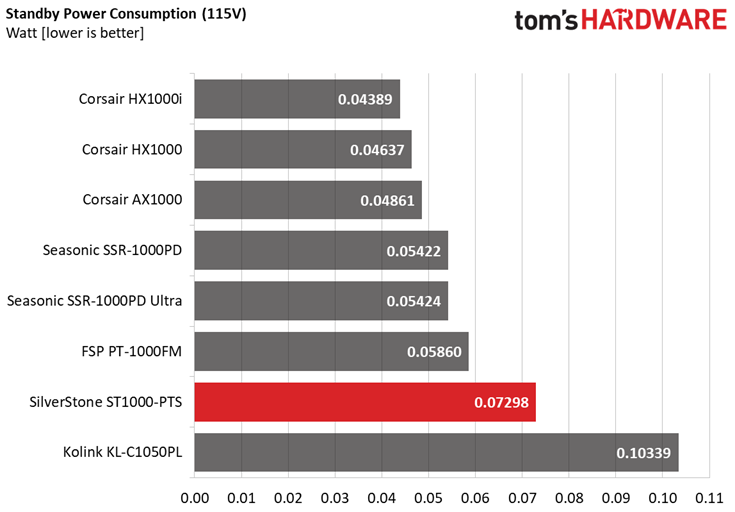
Fan RPM, Delta Temperature, and Output Noise
All results are obtained between an ambient temperature of 37 to 47 degrees Celsius (98.6 to 116.6 degrees Fahrenheit).
The fan profile could be much more subtle. With higher than 700W loads and at higher than 43 degrees Celsius operating temperatures, the fan's speed goes from 976 to 1480 RPM. This is a huge increase; the fan speed change should be more district.
The following results were obtained at 30 to 32 degrees Celsius (86 to 89.6 degrees Fahrenheit) ambient temperature.
Under normal operating temperatures, the fan profile looks good. It takes more than 850W of load, to enter the 30-35 dB(A) range (comparative noise example: quiet rural area). Given the 1kW capacity and the compact dimensions, which affect the airflow at the internals, the ST1000-PTS performs really well when it comes to noise output.
MORE: Best Power Supplies
MORE: How We Test Power Supplies
MORE: All Power Supply Content
Current page: Load Regulation, Hold-Up Time, Inrush Current, Efficiency and Noise
Prev Page Specifications and Part Analysis Next Page Protection Features, DC Power Sequencing, Cross-Load Tests and Infrared Images
Aris Mpitziopoulos is a contributing editor at Tom's Hardware, covering PSUs.




